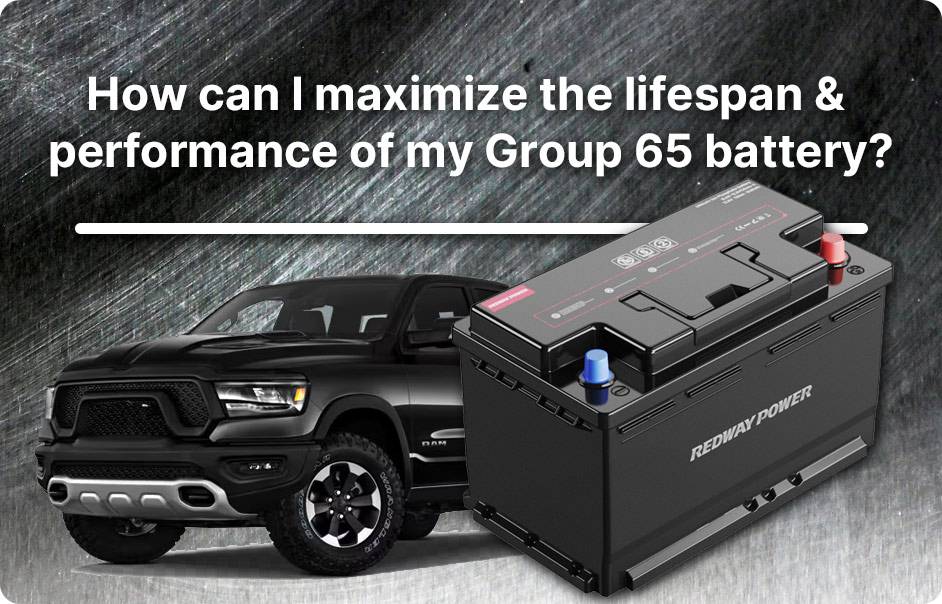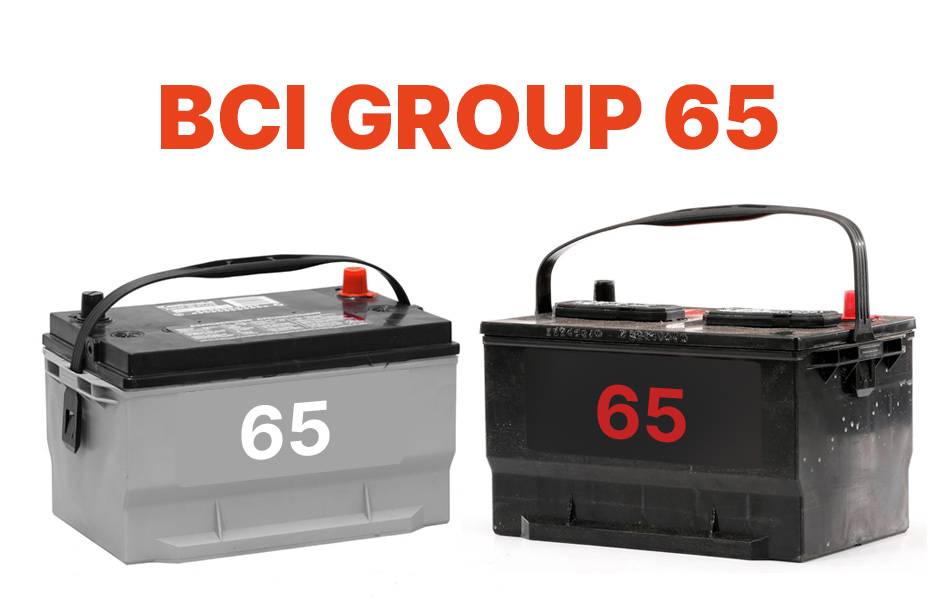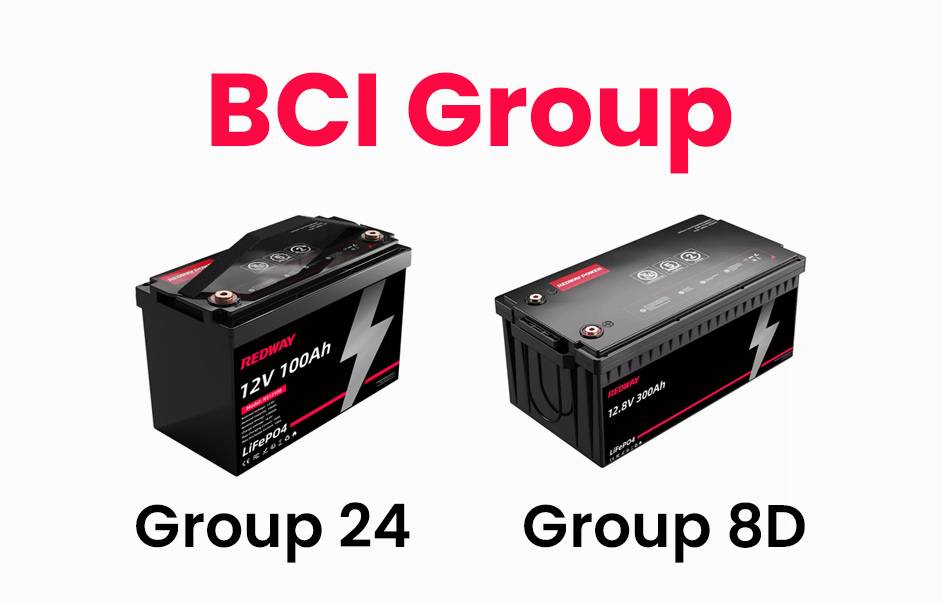As automotive technology advances and vehicles incorporate more electronic features, the need for robust, high-capacity batteries becomes increasingly vital. Group 65 batteries stand at the forefront, offering a blend of exceptional starting power, extended reserve capacity, and durability to meet the requirements of trucks, SUVs, vans, and certain performance cars.
What are BCI Group 65 Batteries?
BCI Group 65 batteries are a standard battery size used in a wide range of vehicles, including passenger cars, commercial vehicles, and heavy equipment. These batteries offer excellent cold starting ability and reliable performance when powering the heavy electronic loads found in modern cars. BCI Group 65 batteries typically measure 12 1/2 x 7 1/2 x 7 9/16 inches (12.0625 x 7.5 x 7.5625 inches, 306 x 190 x 192 mm), abbreviated as 12.1 x 7.5 x 7.6 inches.
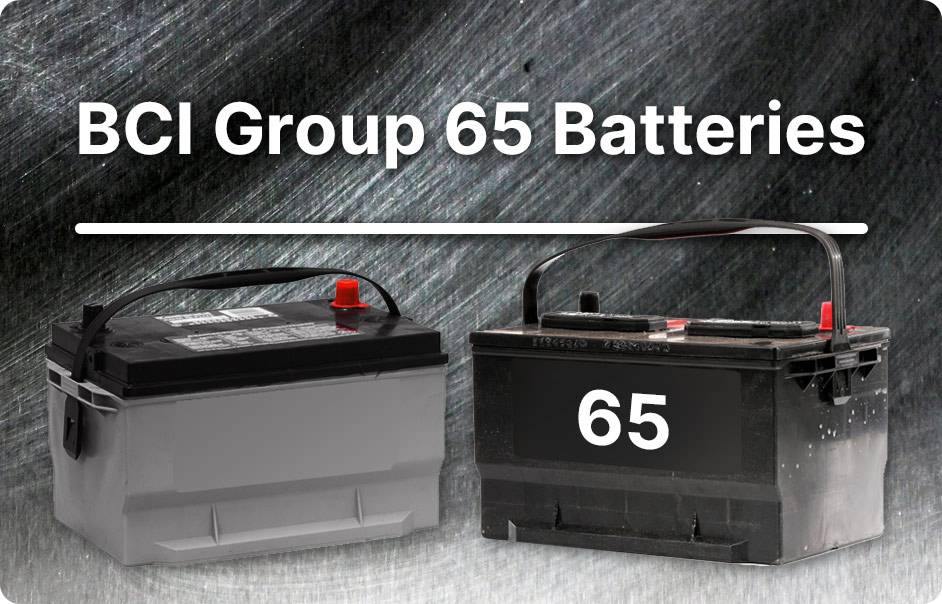
These batteries are commonly lead-acid or absorbed glass mat (AGM) batteries, with AGM technology offering advantages like better resistance to vibration and a longer lifespan.
Key Features of BCI Group 65 Batteries
Group 65 batteries typically offer a 70-75 Ah 20-hour capacity, 130-150 minutes of Reserve Capacity (RC), and 750-950 Cold Cranking Amps (CCA), with some models boasting MCA values nearing 1100 Amps. They generally weigh between 45 and 55 pounds (20 – 25 kg).
- Capacity: These batteries typically offer a 70-75 Ah capacity when discharged over a 20-hour period. However, the actual capacity may vary depending on the discharge rate. Lithium-ion Group 65 batteries boast capacities exceeding 100 Ah.
- Reserve Capacity (RC): With a constant discharge rate of 25 Amps, Group 65 batteries can operate for 130-150 minutes, making them suitable for deep-cycle applications. Lithium-ion batteries in this size category often exceed 200 minutes of RC.
- Cold Cranking Amps (CCA): Group 65 batteries can deliver 750-950 Amps for 30 seconds without the voltage dropping below 7.2V, even at temperatures as low as 0°F (-18°C).
- Marine Cranking Amps (MCA) or Cranking Amps (CA): These batteries provide 950-1070 Amps for 30 seconds at 32°F (0°C), ensuring reliable starting power in various conditions.
- Weight: Group 65 batteries typically weigh between 45 and 55 pounds (20-25 kg), with built-in handles for easy handling by adults. In contrast, lithium Group 65 batteries weigh approximately 11-14 kg, offering significant weight savings. It’s important to note that these values represent the performance of new, fully charged batteries, and actual performance may vary over time and with use.
What are advantages of BCI Group 65 Batteries?
BCI Group 65 batteries offer several advantages:
- High Starting Power: Group 65 batteries are designed to provide a high starting power, which is crucial for larger vehicles with bigger engines.
- Reserve Capacity: They typically have a higher reserve capacity compared to smaller batteries, allowing them to power additional electronic accessories and equipment in the vehicle.
- Compatibility: Group 65 batteries are widely used in various larger vehicles, including trucks, SUVs, and some larger cars, making them readily available and easy to find replacements for.
- Durability: These batteries are built to withstand the demands of larger vehicles and often have robust construction to endure harsh conditions and frequent use.
- AGM Technology Option: Some Group 65 batteries utilize absorbed glass mat (AGM) technology, offering advantages such as better resistance to vibration, longer lifespan, and the ability to be mounted in different orientations without spillage.
- Maintenance-Free Operation: Many Group 65 batteries are sealed and maintenance-free, requiring minimal upkeep compared to traditional flooded lead-acid batteries.
- Long Lifespan: With proper care, Group 65 batteries can have a relatively long lifespan, providing reliable power for the vehicle over an extended period.
Overall, these batteries are chosen for their combination of power, capacity, and durability, making them suitable for larger vehicles with higher power demands.
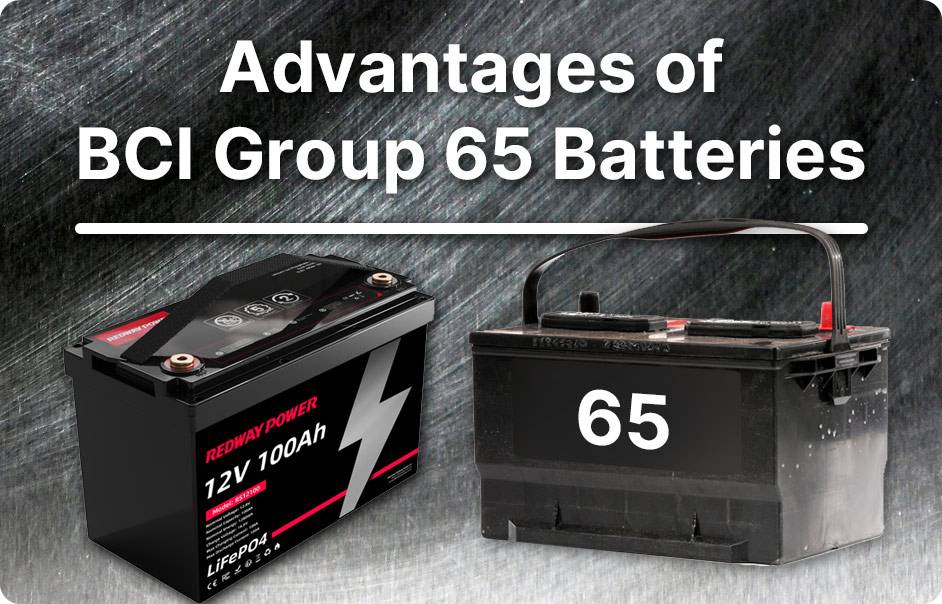
What devices typically use BCI Group 65 Batteries?
BCI Group 65 batteries are primarily used in larger vehicles such as trucks, SUVs, and some larger cars. These batteries are commonly found in vehicles with larger engines and additional power demands due to features like:
- Trucks: Many full-size pickup trucks, especially those with larger engines or towing capabilities, utilize Group 65 batteries to provide the necessary starting power and electrical capacity.
- SUVs: Larger SUVs, particularly those designed for towing or off-road use, often require the high starting power and reserve capacity provided by Group 65 batteries.
- Vans: Some full-size vans, especially those used for commercial purposes or passenger transport, may use Group 65 batteries to meet their power requirements.
- Performance Cars: Certain high-performance or luxury cars with larger engines and advanced electrical systems may also utilize Group 65 batteries to ensure adequate power supply.
Overall, vehicles that require a combination of high starting power, reserve capacity, and durability often rely on BCI Group 65 batteries to meet their energy needs.
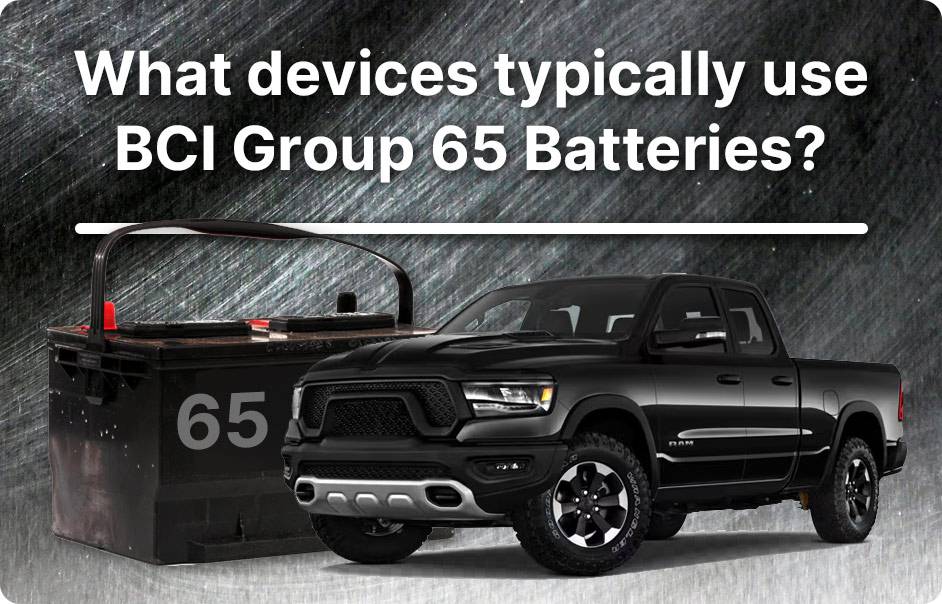
Best Sellers of BCI Group 65 Batteries in 2024
Below is a chart showcasing some of the most popular BCI Group 65 batteries.
| Model | Battery Type Cell Type |
Capacity (Ah) RC (min) |
CCA MCA |
Weight (lbs/kg) Review |
| ACDelco 65AGM | Dual Purpose AGM |
– 120 |
750 – |
42.5 lbs; 19.3 kg |
| ACDelco 65AGMHRC | Dual Purpose AGM |
70 150 |
775 – |
45.8 lbs; 20.75 kg |
| ACDelco 65XAGM | Dual Purpose AGM |
74 145 |
950 – |
58 lbs; 26.3 kg |
| Bosch S6551B S6 | Dual Purpose AGM |
70 140 |
760 910 |
54.9 lbs; 24.9 kg |
| Deka 9A65 | Dual Purpose AGM |
75 150 |
775 955 |
46 lbs; 20.85 kg |
| Delphi BU9065 65 | Dual Purpose AGM |
75 150 |
750 – |
47.5 lbs; 21.5 kg |
| Full Throttle FT930-65 | Dual Purpose AGM |
75 150 |
930 1070 |
57.5 lbs; 26.1 kg |
| NORTHSTAR NSB-AGM65 | Dual Purpose AGM |
69 135 |
930 1070 |
55 lbs; 24.9 kg |
| Odyssey 65-760 | Dual Purpose AGM |
64 129 |
762 890 |
49.8 lbs; 22.6 kg |
| Odyssey 65-PC1750T | Dual Purpose AGM |
74 145 |
950 1070 |
54 lbs; 24.5 kg |
| Renogy RBT100LFP12S-G1 | Deep Cycle Lithium |
100 ~240 |
100A max. cont. | 26 lbs; 11.8 kg |
| XS Power D6500 | Dual Purpose AGM |
75 150 |
– 1070 |
58.3 lbs; 26.4 kg |
Please note: Amazon affiliate links in the ‘Model’ column open in new windows for the most up-to-date prices and offers.
BCI Group 65 AGM batteries typically offer a nominal capacity ranging from 70 to 75 Ah, 750 to 950 CCA, 950 to 1070 MCA, RC values between 130 to 150 minutes, and a weight range of 45 to 55 pounds (20 to 25 kg).
Although less common, BCI Group 65 lithium-ion batteries provide a lighter alternative with higher capacity and extended RC values. For instance, the Renogy RBT100LFP12S-G1 lithium-ion battery boasts a nominal capacity of 100 Ah, an RC value of 230 minutes, and a weight of only 26 pounds (11.8 kg).
Additionally, it offers a maximum continuous discharge current of 100 Amps, 130 Amps one-minute current, a cut-off current of 150 Amps, and a maximum allowed charging current of 50 Amps. With a vast number of charging and discharging cycles, it comes with a 5-year limited warranty.
However, it’s important to note that the lithium-ion option comes at a higher cost compared to AGM Group 65 batteries.
Group 65 1000 CCA Battery – Occasionally, people inquire about Group 65 batteries capable of delivering 1000+ CCA Amps.
While the NorthStar NSB-AGM65 and Odyssey 65-PC1750T batteries come close with 930 and 950 CCA, respectively, neither can produce such current at extremely low temperatures.
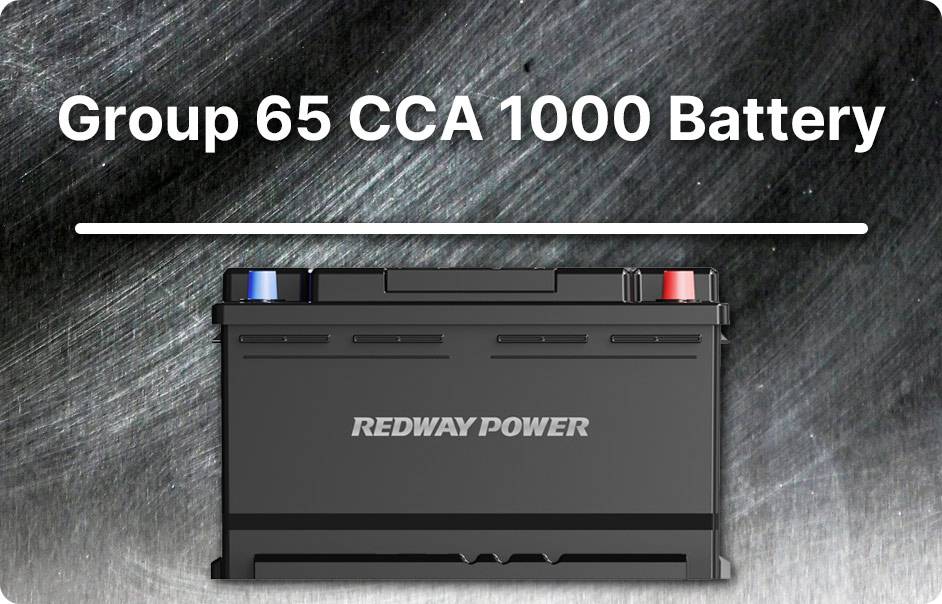
FAQs
What vehicles commonly use BCI Group 65 batteries?
BCI Group 65 batteries are commonly used in larger vehicles such as trucks, SUVs, vans, and some performance cars. These vehicles often require the high starting power and reserve capacity provided by Group 65 batteries to support their larger engines and additional electrical loads.
What are the advantages of Group 65 batteries compared to other battery types?
Group 65 batteries offer advantages such as high starting power, increased reserve capacity for powering additional accessories, compatibility with a wide range of vehicles, durability, and the option for advanced AGM (absorbed glass mat) technology, which provides longer lifespan and better resistance to vibration.
How do I determine if my vehicle requires a Group 65 battery?
You can determine the battery size required for your vehicle by consulting your vehicle’s owner’s manual or contacting a trusted automotive professional. Additionally, many auto parts stores and online retailers provide tools to help you find the correct battery size for your vehicle based on its make, model, and year.
Can I replace my current battery with a Group 65 battery if my vehicle originally had a different battery size?
In most cases, it’s possible to replace your current battery with a Group 65 battery, as long as it fits within the available space in your vehicle’s battery compartment and meets the electrical requirements specified by the manufacturer. However, it’s always best to consult your vehicle’s manual or a professional to ensure compatibility.
What is the difference between traditional lead-acid and AGM Group 65 batteries?
Traditional lead-acid Group 65 batteries use liquid electrolyte, while AGM (absorbed glass mat) batteries utilize a fiberglass mat soaked in electrolyte. AGM batteries offer advantages such as longer lifespan, better resistance to vibration, and the ability to be mounted in different orientations without spillage.
How can I maximize the lifespan and performance of my Group 65 battery?
To maximize the lifespan and performance of your Group 65 battery, it’s essential to follow proper maintenance practices, such as keeping the battery terminals clean and tight, ensuring the battery is securely mounted to prevent vibration damage, and avoiding deep discharges by regularly driving your vehicle or using a battery maintainer when the vehicle is not in use. Regular inspections and testing by a qualified technician can also help identify any issues early on.
